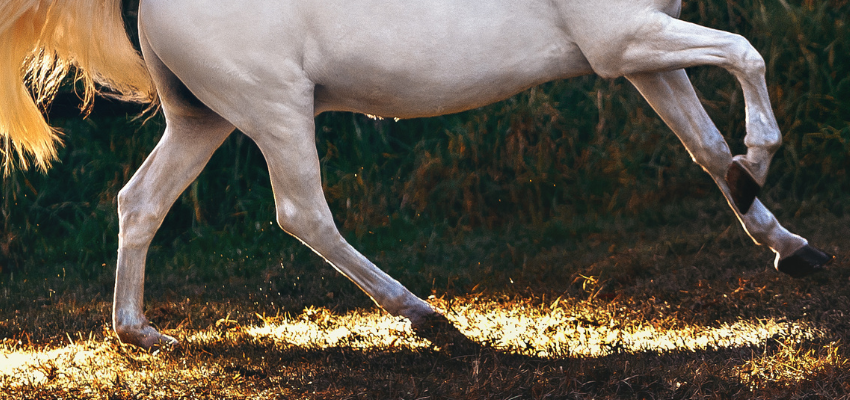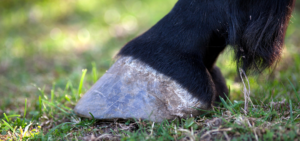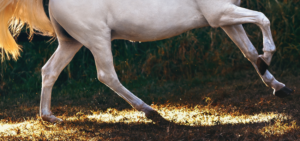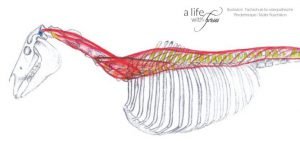Arthritis in horses is a chronic degenerative joint disease. It can have a significant impact on your horse’s mobility, well-being, and quality of life. But what exactly can you do against arthritis? In this article, you will learn everything about the causes, symptoms, diagnosis, treatment, and prevention of the disease.
What is arthritis in horses?
Arthritis is a chronic degenerative joint condition. It advances slowly over an extended period and primarily results from wear and tear, the natural aging process, or prolonged excessive use.
Anatomy and function of a horse joint
To gain a better understanding of arthritis in horses, let’s first examine the anatomy and function of a horse’s joint:
A horse’s joint is where two or more bones come together, covered with cartilage at their ends. This cartilage serves as a cushion, absorbing shock and ensuring smooth movement.
In arthritis, the cartilage progressively deteriorates. As it erodes, the bones begin to rub directly against each other, causing inflammation in the joint. To stabilize the affected joint, the horse’s body starts producing additional bone material, resulting in ossification and eventual stiffening of the joint. Unfortunately, arthritis remains an incurable condition as damaged joint cartilage cannot be restored.
This entire process is highly painful for the horse. To alleviate some of the pressure on the affected joint, the horse often adopts a protective posture. However, this protective stance can negatively impact other ligaments, tendons, muscles, and joints. Additionally, the remaining cartilage receives inadequate nutrients due to reduced stress, further accelerating its deterioration.
Types of arthritis
Arthritis can occur in different parts of the body. Various types of arthritis are distinguished depending on the location of the joint disease. These include:
- Osselets: Osselets are arthritis in the fetlock joint.
- Talonavicular arthritis: Arthritis in the navicular bone.
- Ringbone: Ringbone refers to arthritis in the hoof, coronary, or pastern bone.
Symptoms of arthritis
The symptoms of arthritis in horses can vary depending on the stage of the joint disease. The most common signs of arthritis are:
- Swollen joints
- Warm joints
- Spongy joints with visible galls
- Stiffness
- Lameness
- Changes in gait and movement sequences
- Frequent stumbling
- The horse requires a longer warm-up time to prepare and could be lame when taking the first steps
- Reluctance to move
- Behavioral changes
What causes arthritis in horses?
There can be various causes of arthritis in horses:
- Age: One of the most common causes of arthritis is age. It is normal for cartilage to wear down over time.
- Overweight: An overweight horse has a higher risk of developing arthritis. Excess weight puts strain on the joints and can lead to faster wear and tear on the cartilage.
- Injuries: Previous injuries to the musculoskeletal system such as joint or bone fractures and torn ligaments can be the cause of arthritis in horses. This can lead to overloading or one-sided strain on the joints. Such injuries can often be accompanied by inflammation of the joint. Inadequately treating and improper healing of this condition can further promote arthritis.
- Feeding: If your horse lacks important nutrients, the growth and regeneration process of the bones and joints can be disrupted. In the long term, this can lead to arthritis in the horse.
- Riding: If a horse is ridden too early, too hard, or incorrectly, excessive wear and tear on the articular cartilage can occur. This can cause arthritis in the horse.
- Misalignments: Congenital misalignments of the legs or hooves can also lead to arthritis if they receive inadequate treatment.
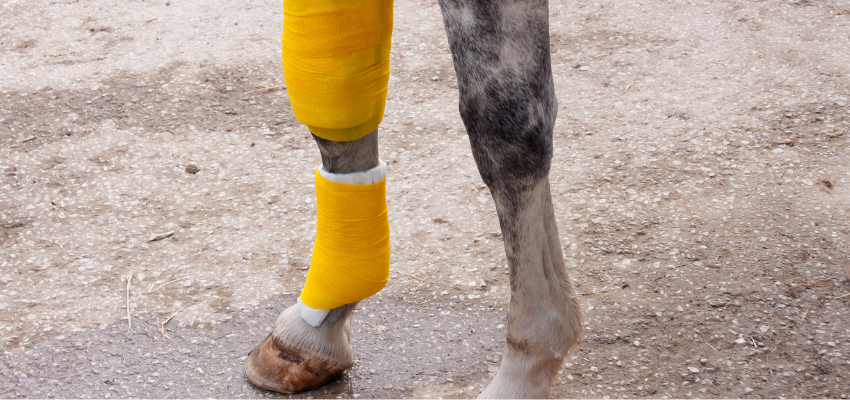
How do you diagnose arthritis in horses?
You can diagnosis arthritis with the following:
- Palpation: First, the veterinarian palpates the horse’s joints, tendons, and ligaments and examines them for mobility, swelling, and pain.
- Lameness examination: A lameness exam involves looking at how your horse moves at different gaits on different surfaces. This makes it possible to determine which joints could be affected by arthritis.
- Flexion test: The horse’s leg is briefly bent during a flexion test and they may feel pain and their gait or movement pattern may change when walking or trotting immediately afterward. This enables conclusions to be drawn for which joint could be affected.
- Diagnostic anesthesia: Individual areas of the leg are systematically anesthetized to pinpoint exactly where the pain is coming from.
- X-rays: Used to detect changes in the bone structure.
- CT or MRI scan: CT or MRI scans of the affected joint can show changes in the cartilage.
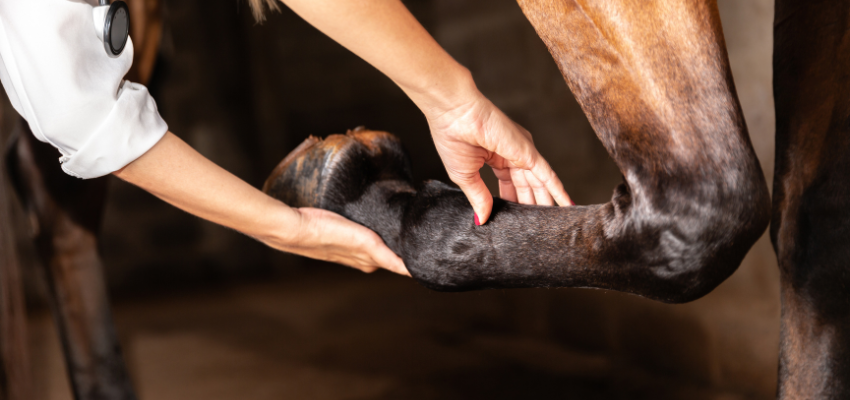
How do you treat arthritis in horses?
Arthritis in horses is not curable. Treatment of the disease aims to improve the horse’s quality of life, relieve its pain, and prevent further wear and tear of the joint. It can look like this:
Medication
The treatment of arthritis frequently requires pain-relieving and anti-inflammatory medications. You can give these medications either orally, mixed with food, or administer them through injections directly into the affected joint.
Injection with Hyaluronic Acid
The synovial fluid, often referred to as a lubricant within the joints, plays a vital role. It prevents further wear and tear on the cartilage while also reducing inflammation. The effect of the injection reduces after a few months but it can be injected repeatedly as needed.

Surgery
If the arthritis has already progressed too far, surgery may be able to help. During an operation, surgeons smooth the rough surface of the cartilage and remove bone splinters. In severe cases, stiffening the joint may also prevent further changes.
How can I support my arthritic horse in everyday life?
If your horse suffers from arthritis, you can do the following to support them:
Movement
A very important aspect is sufficient exercise. Only movement stimulates the production of synovial fluid, which allows the joint to remain supple. Discover on our website a variety of exercises for ground work and in-hand work with your horse, explained step by step.
Can I ride a horse with arthritis?
You can ride a horse with arthritis. To ensure the production of sufficient synovial fluid, it is important to have long warm-up phases that last at least 15 to 20 minutes. For an arthritic horse, it is advisable to avoid tight turns and one-sided loading while favoring straight lines and wide turns. You should also make sure to move your horse on springy and level surfaces. If you are unsure about the intensity and exercises of your workout, it is best to consult your veterinarian.
Attitude
It is good for a horse with arthritis if it can move freely 24 hours a day. An arthritic horse should be kept in an open stable rather than a stall so that it can freely move 24 hours a day. A dry shelter with limited mud and soft bedding is very important. Horses suffering from arthritis often find warmth very pleasant. A blanket, warming creams, or a solarium can contribute to your horse’s well-being.
Feeding
Veterinarians often recommend feeding chondroprotective substances like glucosamine, chondroitin, or hyaluronic acid to slow down arthritis. Herbs can also help reduce inflammation in the joints. Willow bark, devil’s claw, arnica, turmeric, and ginger are popular. You should also make sure that your horse does not become overweight. This way you can avoid putting unnecessary strain on his joints.
How can I prevent arthritis in horses?
These measures can help you prevent arthritis in horses:
- Early and adequate treatment of injuries
- Adequate and regular exercise
- Maintain a sufficiently long warm-up phase
- Adapted training intensity
- Feeding as needed to provide the joints with all the important nutrients
- Avoiding excess weight
- Correct hoof trimming in the event of misalignments
Arthritis is a painful disease that can significantly affect your horse’s well-being and quality of life. Early and appropriate treatment can counteract the disease and alleviate the symptoms.


